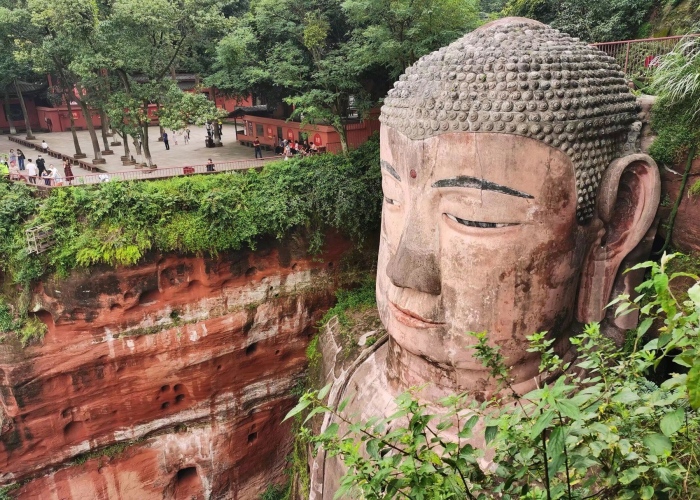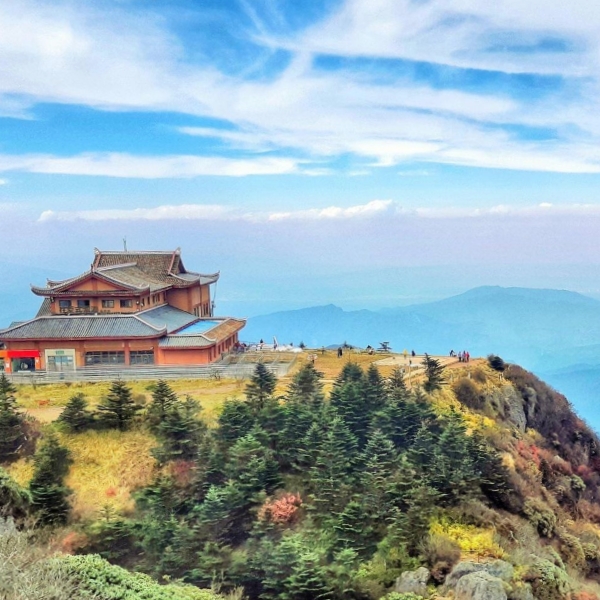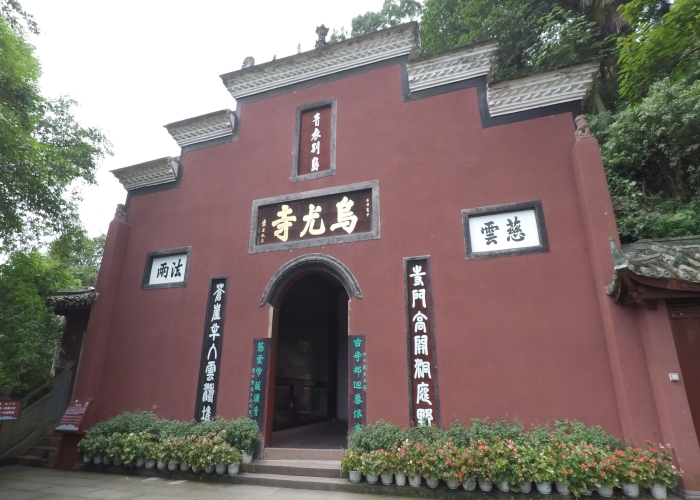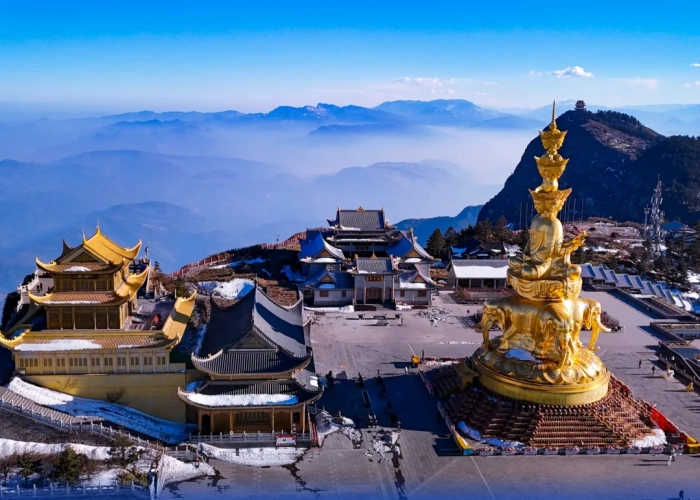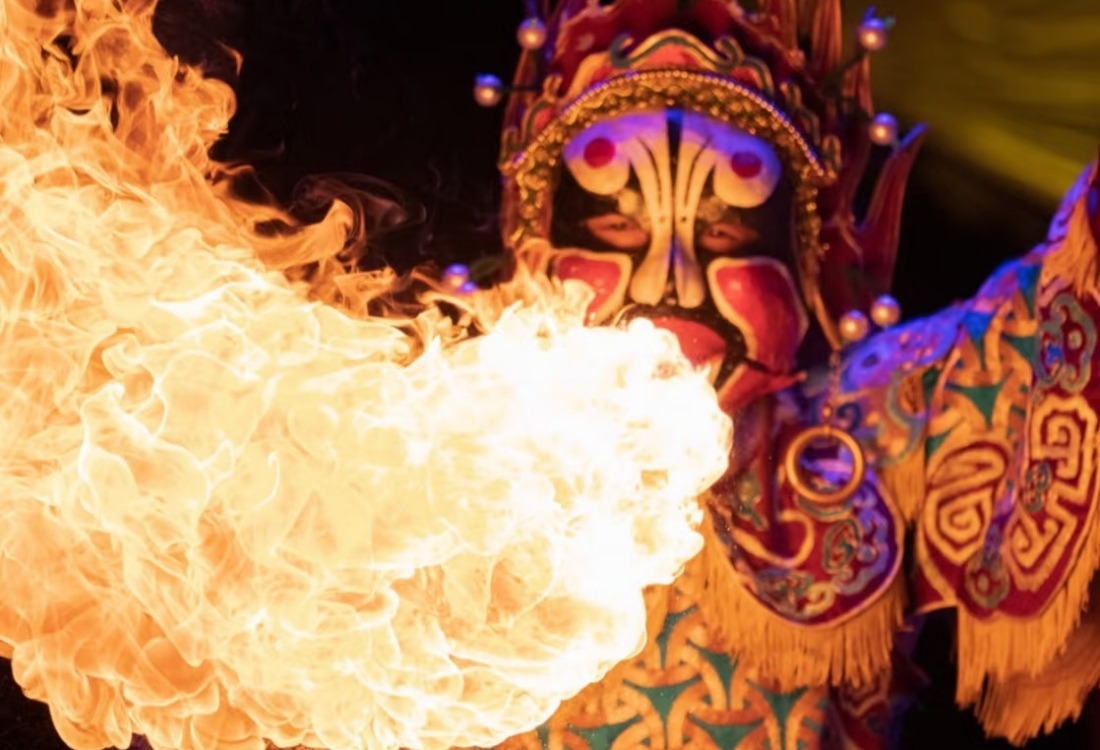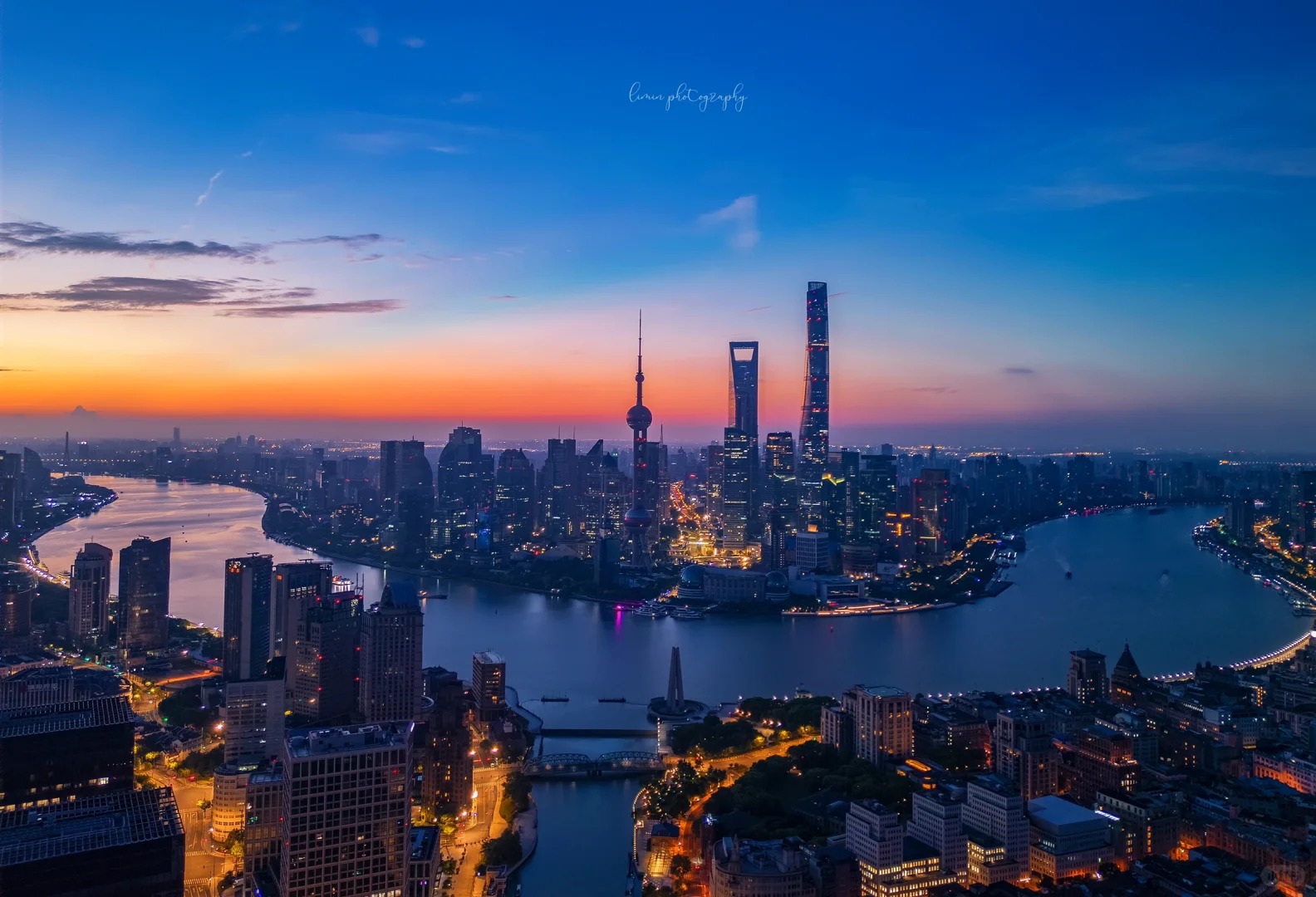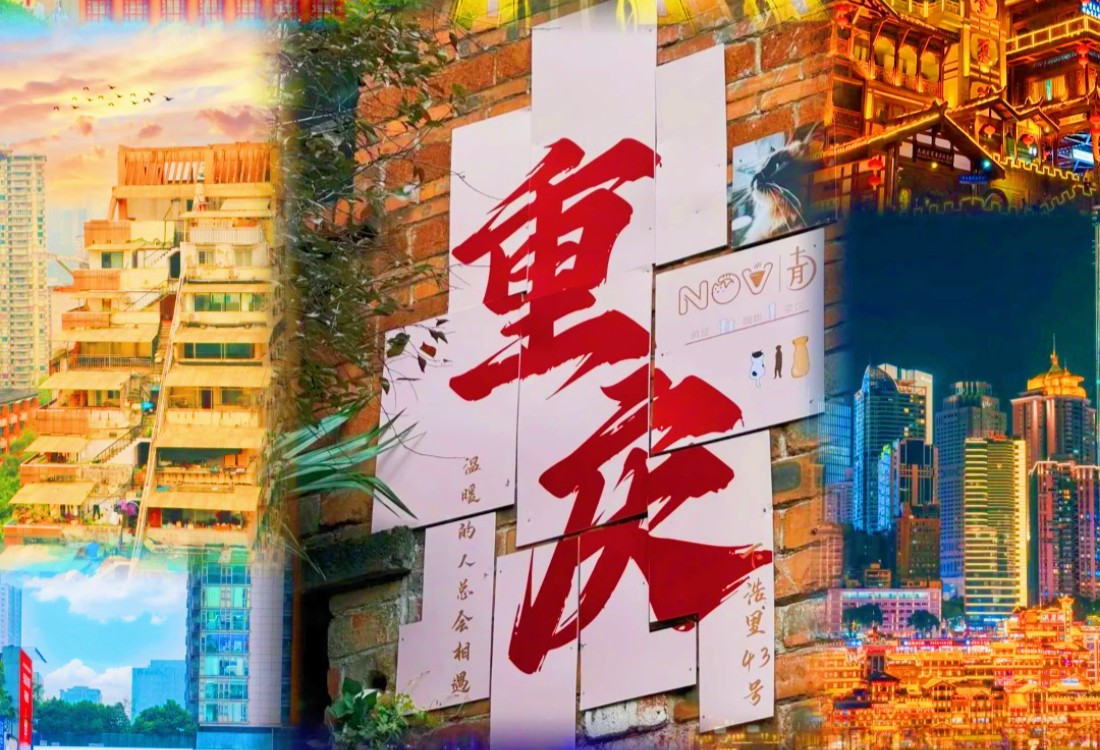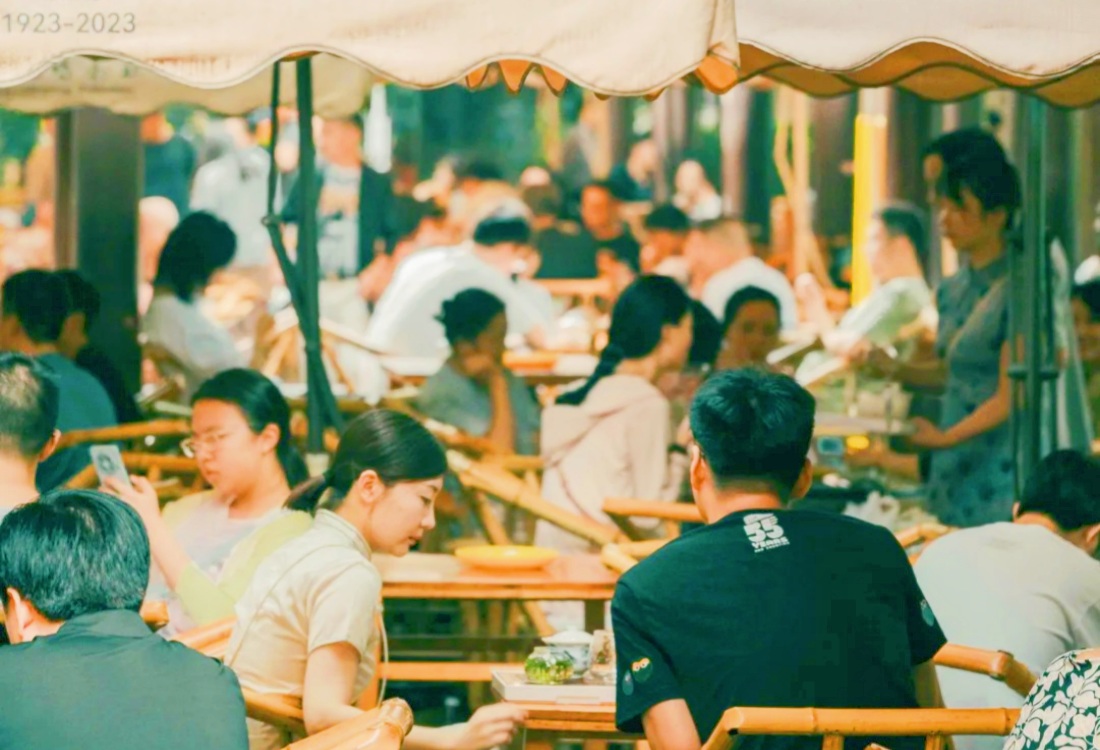Table of Contents
ToggleAre you thinking about visiting the Leshan Giant Buddha in China? This massive stone statue is truly one of the world’s most incredible sights. Imagine a giant Buddha carved right into a cliff face! People come from all over the globe to see it. This guide will tell you everything you need to know for a smooth and amazing trip. We’ve gathered information from reliable travel advice to make planning your visit super easy.
What is the History of Leshan Giant Buddha?
1. Conception and Early Construction (713 AD)
The Leshan Giant Buddha was conceived by the monk Haitong, who initiated its construction in 713 AD to calm the dangerous river currents and bring spiritual protection to the region.
2. Financial Struggles and Haitong’s Death (Mid-8th Century)
After years of fundraising, Haitong died before completion, leaving the project unfinished until his disciples secured further support from local officials and donors.
3. Continued Construction Under Disciples (750–803 AD)
Work resumed under Haitong’s followers, with the project finally completed in 803 AD after nearly 90 years of labor under the Tang Dynasty.
4. Structural Innovations and Drainage System (Tang Dynasty)
Engineers incorporated a sophisticated drainage system within the statue to divert rainwater and prevent erosion, ensuring its long-term preservation.
5. Religious and Cultural Significance (Tang to Qing Dynasties)
Over centuries, the Buddha became a major pilgrimage site, attracting monks, scholars, and travelers who revered it as a sacred symbol of peace and protection.
6. Natural Wear and Early Repairs (Ming and Qing Dynasties)
Weathering and erosion led to periodic repairs, with the Qing Dynasty (1644–1912) conducting significant restorations to maintain its structural integrity.
7. Modern Recognition and Tourism (20th Century)
In the 20th century, the site gained international fame, leading to government-protected status and increased tourism.
8. UNESCO World Heritage Designation (1996)
The Leshan Giant Buddha was inscribed as a UNESCO World Heritage Site in 1996, recognizing its cultural and historical importance.
9. Conservation Challenges (21st Century)
Pollution, weathering, and tourist impact have necessitated ongoing preservation efforts, including cleaning, structural reinforcement, and environmental controls.
10. Present-Day Status and Legacy
Today, the Leshan Giant Buddha remains one of China’s most iconic landmarks, blending religious significance, ancient engineering, and global heritage appeal.
How Tall is the Leshan Giant Buddha?
- Height: 71 meters (233 feet), making it the largest stone Buddha statue globally.
- Head: 14.7 meters (48 feet) high and 10 meters (33 feet) wide.
- Shoulders: An impressive 28 meters (92 feet) across, roughly the width of a basketball court.
- Ears: Each ear is 7 meters (23 feet) long, intricately carved from wood and affixed, and large enough to reportedly hold two people inside.
- Fingers: The smallest fingernail is large enough for a person to sit on, with fingers measuring 8.3 meters (27 feet) in length.
- Feet: Each instep is 8.5 meters (28 feet) wide and can accommodate over a hundred people.
- Hair: The Buddha’s head is adorned with 1,021 meticulously carved spiral hair curls, which are skillfully embedded in the head.
The table below summarizes some of the most striking measurements of the Leshan Giant Buddha, underscoring its colossal scale:
Feature | Measurement(Metric) | Measurement(Imperial) | Noteworthy Detail |
Total Height | 71 meters | 233 feet | World’s tallest pre-modern statue |
Head Height | 14.7 meters | 48 feet | Adorned with 1021 hair curls |
Shoulder Width | 28 meters | 92 feet | Comparable to a basketball court’s width |
Ear Length | 7 meters | 23 feet | Each can supposedly shelter two people |
Finger Length(middle) | 8.3 meters | 27 feet | Showcases intricate carving |
Instep Width | 8.5 meters | 28 feet | Can accommodate over 1200 people |
How to Get from Chengdu to Leshan Giant Buddha?
Most visitors travel to Leshan from Chengdu, the capital of Sichuan Province. It’s pretty easy to get there, and you have a few good options:
High-Speed Train: Fast and Comfortable
This is often the quickest way. High-speed trains leave from Chengdu East Railway Station or Chengdu South Railway Station and arrive at Leshan Railway Station in about 1 hour. Once you get to Leshan Railway Station, you can take a local bus (like bus number 3) or a taxi to the Leshan Giant Buddha scenic area. The bus or taxi ride will take around 30 minutes.
Bus: Budget-Friendly Choice
Buses are a good option if you’re watching your budget. They usually depart from Chengdu’s Xinnanmen Bus Station or Shiyangchang Bus Station. The journey takes about 2 hours. Some buses go directly to the Leshan Giant Buddha scenic area, while others will drop you at Leshan Xiaoba Bus Station. From there, you can catch local bus number 13 or a taxi to the Buddha site.
Private Car or Guided Tour: Convenient and Hassle-Free
For maximum convenience, you can hire a private car or join a guided tour from Chengdu. Many tour companies offer day trips that include transportation and an English-speaking guide. You can also use ride-hailing apps like DiDi (China’s version of Uber) to book a car. Driving yourself, if you rent a car, takes about 1.5 hours via the expressway.
It’s a good idea to plan your travel for early in the morning to avoid heavy traffic, especially if you’re making a day trip.
Transportation Options at a Glance
Here’s a simple table to help you compare how to get from Chengdu to the Leshan Giant Buddha. This can help you decide which option best suits your travel style and budget.
Transportation Mode | Departure Point (Chengdu) | Travel Time (Approx.) | Notes |
High-Speed Train | Chengdu East or South Railway Station | 1 hour (train) + 30 mins (local transport) | Fastest option. Book tickets in advance, especially during peak season. |
Bus | Xinnanmen or Shiyangchang Bus Station | 2 hours (bus) + local transport | Economical. Check bus schedules. Some go direct to scenic area. |
Private Car / Guided Tour | Your accommodation | 1.5 – 2 hours | Most convenient, especially for groups. Can be part of a guided tour. |
What is the Best Way to See the Leshan Giant Buddha?
You have two main options for experiencing the Leshan Giant Buddha, and each offers a different perspective. Many visitors try to do both if they have time!
1.The Walking Tour: Get Up Close and Personal
This option lets you explore the scenic area on foot. You typically enter at the top of Lingyun Mountain, near the Buddha’s head. From there, you can:
- Walk down the Nine Bends Plank Road: This is a narrow, steep, and winding staircase carved into the cliffside that takes you all the way down to the Buddha’s giant feet. It offers incredible close-up views from different angles. Be prepared for a bit of a workout, and it can get crowded, especially during peak times. Wear comfortable shoes!
- Visit Lingyun Temple: Located near the Buddha’s head, this ancient temple is worth exploring. It has a peaceful atmosphere and offers more great views.
- Explore surrounding areas: There are other carvings, pagodas, and viewpoints within the park.
The walking tour is included in your main entrance ticket. It generally takes 2-3 hours, depending on your pace and how long you stop for photos.
2.The Boat Tour: A Panoramic Spectacle
If you prefer a less strenuous way to see the Buddha or want a fantastic overall view, the boat tour is an excellent choice. Boats depart from a dock near the scenic area and take you out onto the river.
- Full frontal view: The boat tour provides a stunning, unobstructed view of the entire Buddha from the water. This is where you can truly appreciate its immense scale against the cliff.
- Quick and easy: The ride usually lasts about 30 minutes. It’s a good option if you’re short on time or have mobility concerns.
- Photography: This is arguably the best way to get a photo of the whole Buddha.
You won’t get to see the intricate details up close or visit the temples on land, but the perspective from the river is unique.
What is the Best Time to Visit the Leshan Giant Buddha?
The best time to visit Leshan Giant Buddha are Spring(April to May) and Autumn(September to October). Choosing the right time to visit can make your experience even better. Sichuan’s weather can vary, so consider the seasons:
- Spring (April to May): This is a lovely time. The weather is usually mild, with temperatures around 15-25°C (59-77°F). Flowers are blooming, and it’s generally not too crowded.
- Autumn (September to October): Many people think this is the best time. The air is cool and clear, ideal for walking and taking photos. Temperatures are typically 15-20°C (59-68°F). However, this is a popular season, so try to visit on a weekday if possible.
- Summer (June to August): Summers can be hot and humid, with temperatures sometimes reaching 30°C (86°F) or higher. It can also be rainy. This is a busy period with school holidays, so expect more tourists. Don’t forget rain gear and sunscreen!
- Winter (November to February): If you prefer fewer crowds, winter might be for you. However, it can get quite cold, with temperatures sometimes dropping to around 5°C (41°F). Fog can also be an issue and might obscure your view of the Buddha.
Pro Tip: Try to avoid major Chinese public holidays, like Golden Week (the first week of October) and Chinese New Year (usually late January or February), as these are extremely crowded times. Visiting on a weekday and arriving early in the morning (the site often opens around 8:00 AM) is generally a good strategy to beat the biggest crowds. Early morning light is also great for photos!
What are the Nearby Tourist Attractions of Leshan Giant Buddha?
While the Giant Buddha is the main star, the area around Leshan offers more interesting sights:
- Lingyun Temple: As mentioned, this ancient temple is located right at the head of the Giant Buddha. It’s an active place of worship with beautiful architecture and courtyards.
- Wuyou Temple: Situated on Wuyou Hill, across the river from the Giant Buddha, this temple complex offers a quieter, more serene atmosphere. It houses many Buddhist statues and provides lovely views.
- The Giant Sleeping Buddha: This is a fascinating natural rock formation of several hills that, when viewed from a distance (often from the boat tour or specific viewpoints), resembles a giant reclining Buddha, with the Leshan Giant Buddha nestled at its heart.
- Mount Emei (Emei Shan): If you have more time (an extra day or two), consider a trip to Mount Emei. It’s one of China’s Four Sacred Buddhist Mountains, located about 40 kilometers (25 miles) from Leshan. It’s a UNESCO World Heritage site in its own right, known for stunning mountain scenery, numerous temples, and hiking trails. Many visitors combine Leshan and Mount Emei into one trip.
Where to Stay and Eat?
Accommodation
Leshan city offers a range of places to stay, from budget-friendly guesthouses to more comfortable mid-range hotels. You can find options conveniently located near the scenic area or in downtown Leshan. If you’re making a day trip from Chengdu, you might not need accommodation in Leshan itself.
Local Food
Don’t miss the chance to try some authentic Sichuan cuisine! Leshan is known for its delicious and often spicy food. Look out for local specialties such as:
- Leshan Sweet-Skinned Duck (甜皮鸭 – Tián Pí Yā): A local delicacy.
- Spicy Hotpot (火锅 – Huǒguō): A Sichuan classic.
- Various Street Foods: You’ll find tasty snacks like barbecued skewers, dumplings, and local noodle dishes in Leshan city and sometimes around the scenic area.
Exploring the local food scene can be a great addition to your cultural experience.
What are the Opening Hours and Practical Tips of Leshan Giant Buddha?
Opening Hours
The opening hours can vary slightly depending on the season:
- Peak Season (usually April 1 to October 7): 7:30 AM – 6:30 PM
- Off-Season (usually October 8 to March 31): 8:00 AM – 5:30 PM
It’s always a good idea to check the latest official information before your visit, as hours can sometimes change.
Handy Tips for a Smooth Visit
- Go Early: Arriving before 9:00 AM, especially on weekdays, helps you avoid the largest crowds and enjoy the site more peacefully.
- Wear Comfortable Shoes: You’ll be doing a lot of walking, and the Nine Bends Plank Road involves many steep stairs.
- Stay Hydrated & Bring Snacks: Carry a water bottle and some light snacks. While there are some vendors, options inside the park can be limited and more expensive.
- Check the Weather: Sichuan weather can be unpredictable. Dress in layers. It might be cooler at the top near the Buddha’s head and warmer as you descend or if it’s sunny. Rain gear is useful, especially in summer.
- Bring Your Camera: The views are spectacular, so make sure your camera or phone is charged!
- Be Respectful: Remember this is a significant religious and cultural site. Dress modestly (cover shoulders and knees if possible) and behave respectfully.
Frequently Asked Questions (FAQs) about the Leshan Giant Buddha
How long does it take to visit the Leshan Giant Buddha?
Most people spend about 2-4 hours at the Leshan Giant Buddha scenic area if doing the walking tour. This includes walking down to the Buddha’s feet, visiting Lingyun Temple, and exploring a bit. If you add a boat tour (around 30 minutes) and travel time from Chengdu (1-2 hours each way), it can easily be a half-day or full-day trip.
Is the Leshan Giant Buddha suitable for children or elderly visitors?
The boat tour is suitable for all ages and mobility levels. The walking tour, especially the Nine Bends Plank Road, involves many steep and narrow stairs, which can be challenging for young children, the elderly, or those with mobility issues. However, you can still visit the top area near the Buddha’s head and Lingyun Temple without going down all the stairs.
What should I wear when visiting?
Wear comfortable walking shoes. Dress in layers as the weather can change. Since it’s a religious site, somewhat modest clothing (covering shoulders and knees) is appreciated, though not strictly enforced for tourists like at some other religious sites.
Are there restrooms and food facilities at the site?
Yes, there are restrooms available within the scenic area. There are also places to buy snacks and drinks, though options might be more limited and pricier than outside the park. It’s a good idea to bring your own water and some snacks.


